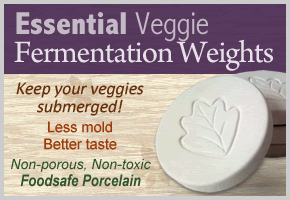QUESTIONSScience & Health
Methods & Tools
Storage & Safety
Yogurt, Whey, Greek Yogurt, Yogurt Cheese
Sauerkraut
Crunchy Carrot Sticks “Pickles”
Bean Dip
ANSWERSScience & HealthWhat is lacto-fermentation? Why should one eat lacto-fermented foods, what are the benefits? Can I eat lacto-fermented foods even though I’m lactose or dairy intolerant?
Are canned (processed), dehydrated, or frozen vegetables able to be fermented? If I heat or warm my fermented foods will the health benefits be diminished? Can I use my fermented foods in cooked or non-cooked (raw) recipes? Method & ToolsDo I have to use salt in fermenting, or can I reduce the amount of salt called for in the recipe? My vegetables keep floating above the brine. Is this okay, or will it spoil my ferment? Keeping vegetables submerged can be one of the trickiest things about fermenting. But it is a very important step. In order to virtually eliminate issues with mold and other spoilage, it is important to keep the vegetables submerged during the entire fermenting process. The easiest way to keep those stubborn vegetables down is to use "fermentation weights". Fermentation weights should be made of food-safe and non-porous materials, like ceramic/porcelain or glass. Our Essential Veggie Fermentation Weights are an ecomomical and safe option. In the mean time, if you do not have weights available, you can open up the ferment and push the vegetables back down. Though the vegetables will inevitably want to float again. You will then have to repeat this process, which is not ideal. Everytime you open the jar there is a chance that some foreign bacteria in the air could contaminate your ferment. Storage & SafetyCan I get food poisoning from eating fermented foods? How long do fermented foods last? Why do my fermented foods sometimes taste a little different from batch to batch? Vegetables can taste different from season to season and farm to farm. The soil conditions, weather, etc come into play – this is the very same reason that fermented foods will taste different at different times of the year. You are making a natural product so tastes can vary slightly, this is completely normal. Yogurt, Whey, Greek Yogurt, Yogurt CheeseHow long can I expect my yogurt, whey, yogurt cheese to last in the refrigerator?
Why does my freshly made yogurt smell / taste "yeasty? If your freshly made yogurt smells or tastes yeasty then it is probably due to the "culture" being old. After weeks or months of making yogurt the culture gets weakened. Simply purchase a new store-bought "live" yogurt from the store to start a new batch. My yogurt did not turn out… it is runny or lumpy. Why is this? This could be for a number of reasons – such as a possible "weak" culture, incorrect temperatures, yogurt not being insulated sufficiently during culturing etc. If you are having trouble getting your yogurt to "set" or culture properly we would suggest looking over the details of the lesson and the recipe. I would like to flavor my yogurt. When can I add in fruit / sweetener/ other flavorings? We always recommend never adding any fruit, sugars, or other flavoring to the yogurt before or after culturing. Your "Mother" batch should be kept pure. Adding fruits or sugars will greatly speed up the "break-down" of your yogurt, causing it only last a few days. If you desire to flavor your yogurt always add it to the serving bowl as each individual likes. I prefer my yogurt really thick. What can I do to get it thicker? If you want thicker yogurt there are three things you can try. We suggest giving each a try and see what you prefer.
SauerkrautMy sauerkraut has been fermenting for a couple of days now and is overflowing the jar. What happened? Can I add more brine to my sauerkraut in the middle of fermenting if it looks dry? After only a short time of fermenting my sauerkraut starts floating, what should I do? Crunchy Carrot Sticks “Pickles”My brine has turned from clear to cloudy and/or there is white sediment on the bottom of my jar. Is this normal? I pack my carrots in the jar tightly, but during fermenting they still float and mold on top. How can I prevent this? Bean DipAfter 3 days of fermenting the top layer of my beans looks darker… did something go wrong? Is it okay to heat the beans before serving?
|
|
...obtaining better health with God foods
Disclaimer
The nutritional advice provided through this website is intended to educate individuals about diet and a healthy lifestyle approach. No advice provided is intended to diagnose, cure, or prevent any disease; or be construed as a substitute for medical attention. Individuals with a specific medical condition or concern should seek advice from a physician.
Copyright © 2016 Cooking God's Way · License & Usage · Disclaimer & Privacy Notice · Shipping & Refunds · Affiliate Program





